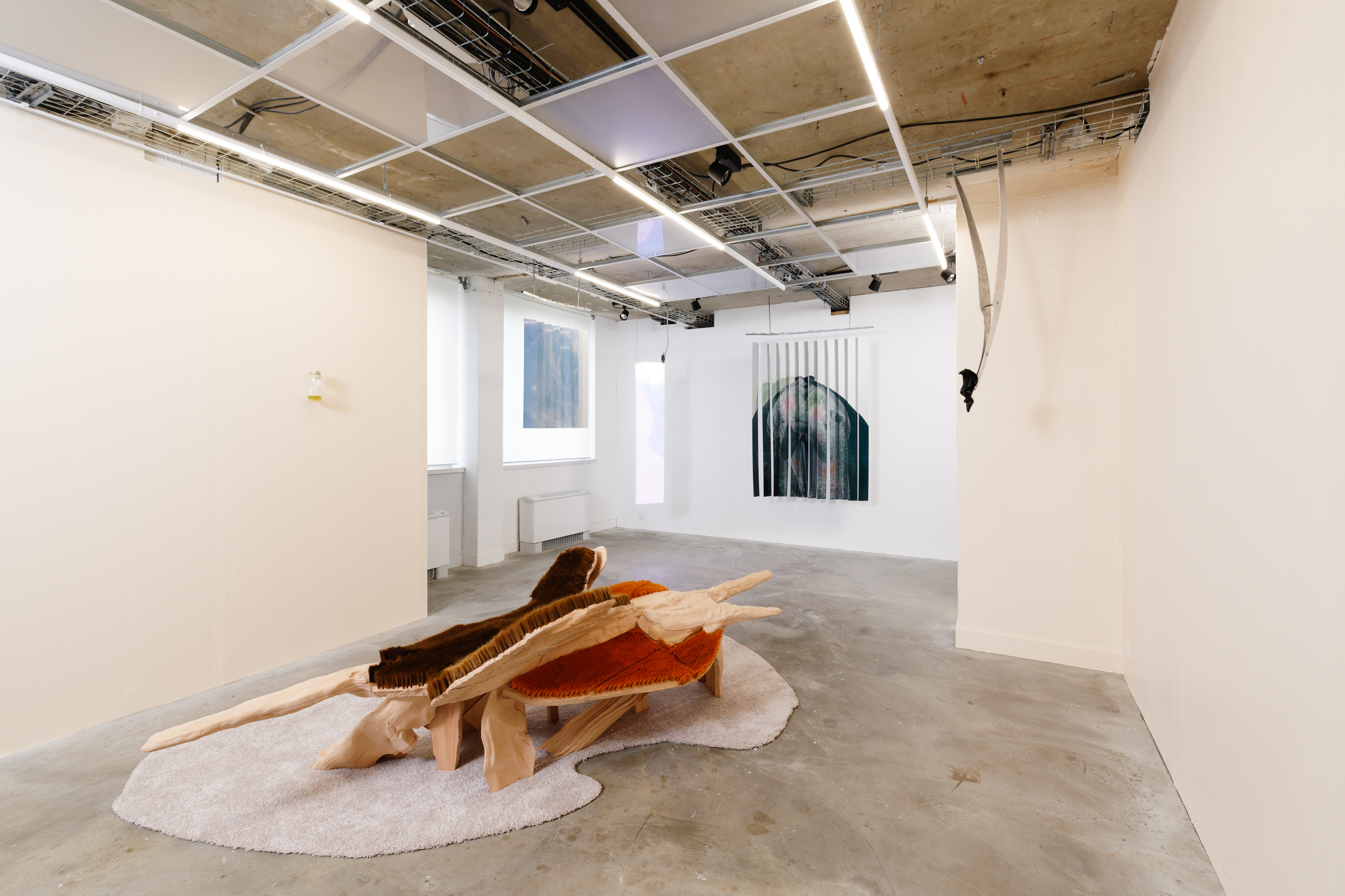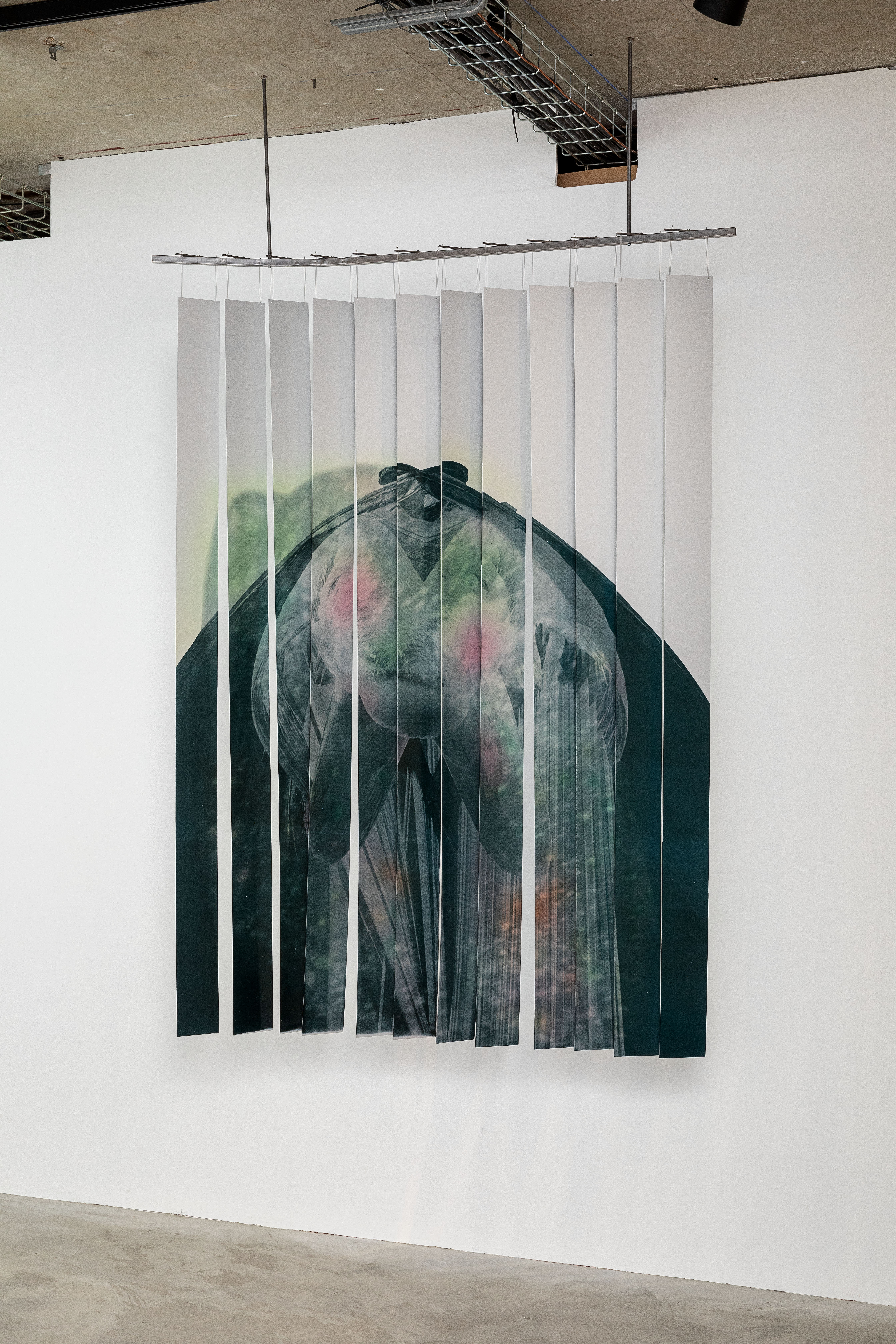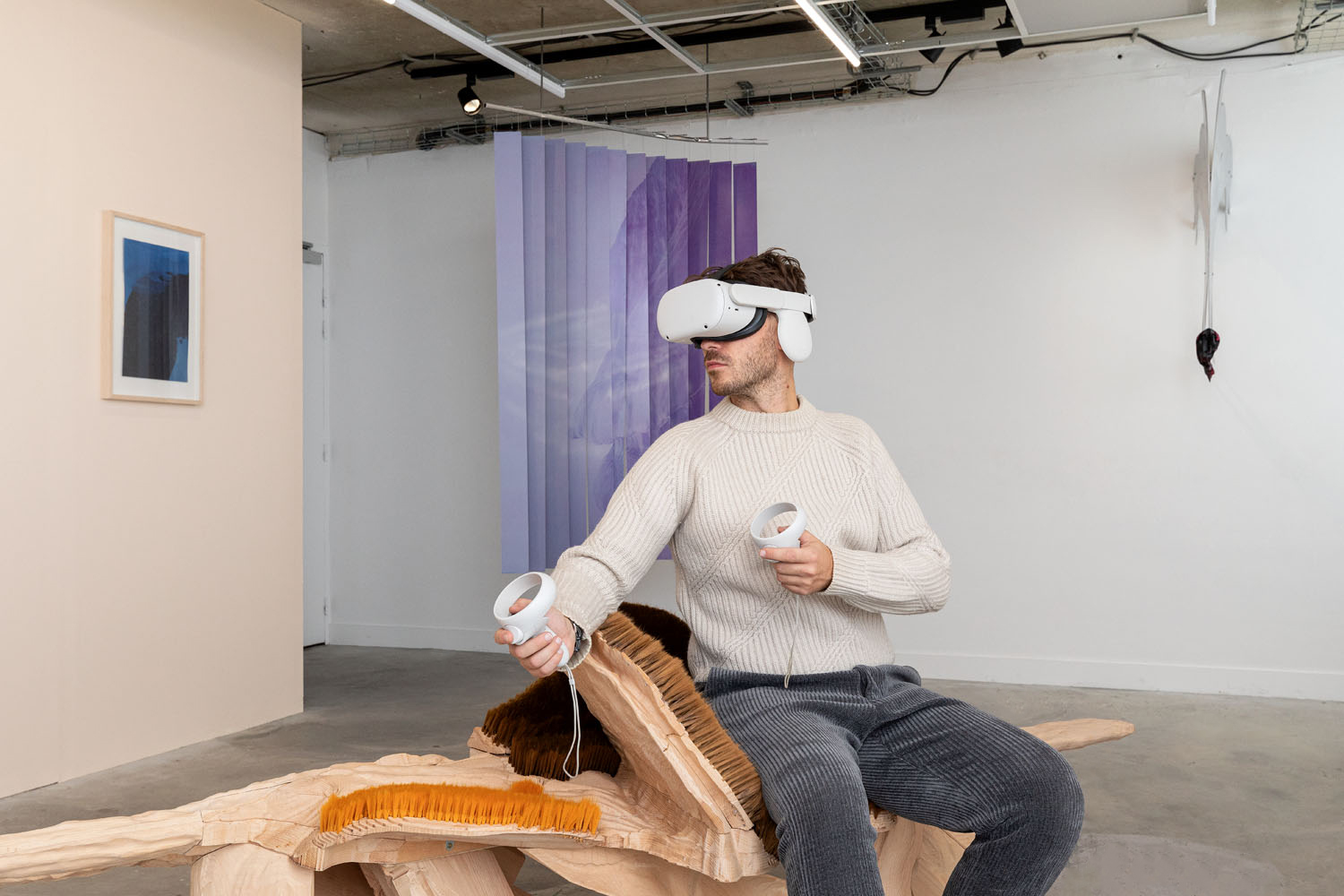
Le Temps Scintille Et Le Songe Est Savoir, Double Sejour, Poush Manifesto, Paris, FR
16.10 – 20.11 2021
curated by Thomas Havet
Time’s all a shimmer
Olivier Zeitoun, Assistant Curtor, Centre Pompidou
How to sit and snuggle up in the hollow of infinite and virtual worlds? Ittah Yoda’s installation for Double Sejour weaves a playful, and almost therapeutic bond as a collective and emancipatory alternative to the digital networks that surround and control.
Is sitting a rite as old as eating, playing cards, debating, working on your computer, drinking alcohol, playing an instrument, seeing a doctor, painting, contemplating an artwork, taking part in a meeting, embroidering, governing? Who can sit or lie down and when? Why were women so rarely represented seated, and men so rarely reclining?
A wooden sculpture-seat covered with soft bristles occupies the center of the space, for us to lie or sit on. This is a first point of contact with the living, with which the artistic duo collaborates harmoniously: we are sitting on a sensitive surface, an animal skin, which took shape on a software by an assembling and demultipliying organic forms. The object welcomes and guides us towards fresh worlds.
The space around is structured by metal plates used for lithography, suspended and sliced up to let fractioned images appear on their surface. One distinguishes the growing forms composing the bench, in very close-up. Projected paint on these surfaces suggests the superimposition of second images. They originate in the artists’; memories of threedimensional confocal scans of marine microorganisms. Sculptures in glass paste emerge from the walls, the ceiling and the floor. A layer of concrete on the ground, like a projected shadow, supports the whole. The environment absorbed living and phantom forms while their generation goes on.
The physical experience is doubled by a mental one, which is activated once seated, or lying down, wearing a headset. Embedded in the landscapes, we melt into them. From the surface to the mind, the waking dream projects itself in all directions of the physical and mental environment of the place and time: “ Time’s all a shimmer, and to dream’s to know”.
Virtual reality, which acts when one is still, frees from physical constraints, from terrestrial gravity; archaic signals synchronize in our flying heads. The circuits of the virtual dream activate its immediate connections. An LED display offers a glimpse of what others are seeing inside the VR. One thinks of a language which could give way to other forms of communication, primary and active, such as those of the octopus or the cuttlefish which change shapes and colors to express themselves: “I always had this dream, when I was a child, that I could open my mouth and a projection would come out (...) Or maybe I would have an image on my skin like the giant Cuttlefish ”(Philippe Parreno).
Virtual reality is a form of life with immediate connections with which to dialogue; which thinks itself autonomous, synaesthetic, underwater. Sitting positions, mental architectures: the ritual of a new system of beliefs and patterns that can be activated, all postures dreamed of. This metamorphic world is another system, just as alive as the one where the body forget itself when it sleeps, but continues to live on its reclining, infinite journey.
“A sleeping man holds in a circle around him the sequence of the hours, the order of the years and worlds” (Marcel Proust)
1 Philippe Parreno and Philippe Parreno, Hans Ulrich Obrist, Conversation Series 14, Cologne, Walther König, 2008, p. 63
Le Temps scintille
Texte de l’exposition par Olivier Zeitoun
Comment s’asseoir et se blottir au creux de mondes infinis et virtuels ? L’installation d’Ittah Yoda pour Double Séjour tisse un lien ludique, presque thérapeutique, comme alternative collective et émancipatrice aux réseaux numériques qui enserrent et contrôlent.
S’asseoir est-il un rite aussi ancien que manger, jouer aux cartes, débattre, travailler sur son ordinateur, boire de l’alcool, jouer d’un instrument, consulter un médecin, peindre, être au musée, prendre part à une réunion, broder, gouverner ? Qui peut s’asseoir ou se coucher, et quand ? Pourquoi les femmes ont-elles été si rarement représentées assises, et les hommes si rarement couchés ?
Le parcours s’opère librement. Au centre de l’espace se trouve une sculpture-assise en bois fichée de tiges de poils doux, sur laquelle se coucher ou s’asseoir. Elle est un premier point de contact avec le vivant, avec lequel le duo collabore en bonne intelligence : nous sommes assis·es sur une surface sensible, une peau animale, qui a pris corps sur logiciel par un assemblage de formes organiques démultipliées. L’objet accueille et guide vers des mondes frais.
Autour, l’espace se structure par des plaques métalliques employées pour la lithographie, suspendues et sectionnés pour laisser apparaître à leur surface des images fractionnées. On y distingue les formes croissantes du banc, en très gros plan. De la peinture projetée suggère en surimpression de secondes images. Elles trouvent leur origine dans le souvenir des artistes de scans confocal en 3 dimensions de micro-organismes marins. Des sculptures en pâte de verre surgissent des murs, du plafond et du sol. Une couche de béton à terre, comme une ombre projetée, soutient l’ensemble. L’environnement a absorbé les formes, vivantes et fantômes, tout en continuant leur génération.
L’expérience physique se double de celle mentale, qui s’active une fois assis, ou couché, vêtu d’un casque. Encaissé·e·s dans les paysages, pour s’y fondre. De la surface jusqu’à l’esprit, le rêve éveillé se projette dans toutes les directions de l’environnement physique, mentale, du lieu et du temps : « Le Temps scintille et le Songe est savoir ».
La réalité virtuelle, qui agit quand on est immobile, se dégage de la contrainte physique, de la gravité terrestre ; d’archaïques signaux se synchronisent dans nos têtes volantes. Les circuits du rêve virtuel activent ses connexions immédiates. Un écran LED donne l’aperçu de ce que d’autres voient à l’intérieur de la VR. On songe à un langage qui pourrait laisser place à d’autres formes de communication, primaires et actives, comme celles du poulpe ou de la seiche qui changent de formes et de couleurs pour s’exprimer : « J’avais toujours ce rêve quand j’étais enfant, que je pourrais ouvrir ma bouche et qu’une projection en sortirait (…) Ou peut-être que j’aurais une image sur ma peau comme le Cuttlefish géant » (Philippe Parreno1).
La réalité virtuelle est une forme de vie aux connexions immédiates avec laquelle dialoguer ; qui se songe autonome, synesthésique, sous-marine. Positions assises, architecture mentale : le rituel d’un nouveau système de croyances et de motifs que l’on peut activer, toutes postures rêvées. Ce monde métamorphique est un autre régime, tout aussi vivant que celui ou le corps s’oublie quand il dort, mais continue de vivre dans son voyage couché, infini.
« Un homme qui dort, tient en cercle autour de lui le fil des heures, l’ordre des années et des mondes. » (Marcel Proust)
1 Philippe Parreno dans Philippe Parreno, Hans Ulrich Obrist, Conversation Series 14, Cologne, Walther König, 2008, p. 63
Press:
THE STEIDZ
O FLUXO

























Seat sculpture in collaboration with Thomas Havet
Special Thanks for VR design to Marta and Tea Strazicic
Sound Design by bod [包家巷]
Photography by Aurélien Mole and Romain Darnaud